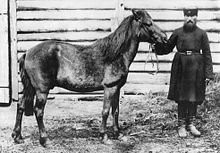| Tarpan Temporal range:
| |
|---|---|

| |
| The "Cherson tarpan", the only tarpan to be photographed, 1884 | |
| Scientific classification | |
| Domain: | Eukaryota |
| Kingdom: | Animalia |
| Phylum: | Chordata |
| Class: | Mammalia |
| Order: | Perissodactyla |
| Family: | Equidae |
| Genus: | Equus |
| Species: | |
| Subspecies: | †E. f. ferus
|
| Trinomial name | |
| †Equus ferus ferus Boddaert, 1785
| |
| Synonyms | |
| |
The tarpan (Equus ferus ferus) was a free-ranging horse subspecies of the Eurasian steppe from the 18th to the 20th century.[1] It is generally unknown whether those horses represented genuine wild horses, feral domestic horses or hybrids.[1] The last individual believed to be a tarpan died in captivity in the Russian Empire in 1909.[2]
Beginning in the 1930s, several attempts were made to develop horses that looked like tarpans through selective breeding, called "breeding back" by advocates. The breeds that resulted included the Heck horse, the Hegardt or Stroebel's horse, and a derivation of the Konik breed, all of which have a primitive appearance, particularly in having the grullo coat colour. Some of these horses are now commercially promoted as "tarpans", although such animals are only domestic breeds and not the wild animal themselves.
